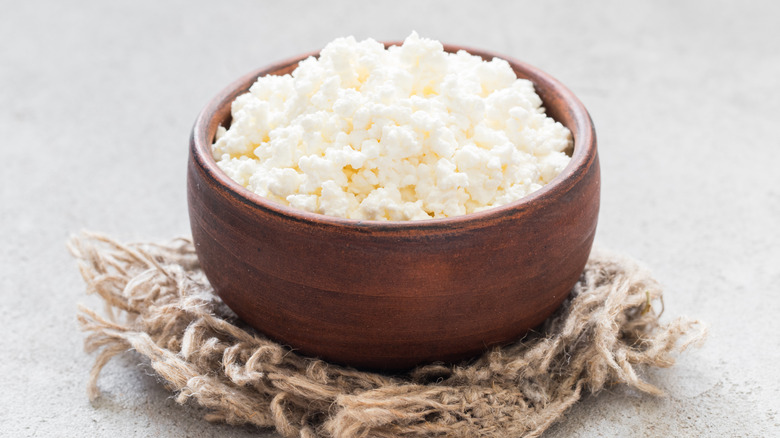Can Cottage Cheese Be Frozen Or Is Fresh Truly Better?
In a world with ever-rising grocery prices, being mindful of what we buy and knowing how to extend our foods' shelf-life is increasingly important. For instance, if the price of eggs it too high, you may find yourself turning to more cost-effective alternatives, such as cottage cheese. Not only is cottage cheese a tasty and versatile breakfast option, it's also a fairly good replacement for eggs in baking, and makes a delicious sweet or savory snack. Chock full of protein and other key nutrients, it's no wonder cottage cheese is making a bit of a comeback.
Of course, the risk with purchasing any refrigerated item in bulk is that it could go bad before you can finish it — something that's both annoying and hard on your wallet if it happens too often. However, you can easily keep your surplus of cottage cheese fresh and safe to eat by simply popping it in your freezer. Once frozen, it'll stay fresh for between 2 and 6 months, giving you plenty of time to plan how to use it later on.
To ensure your cottage cheese lasts as long as possible, you'll want to put it in an airtight container. This may be the original container if you haven't opened it, but if you've already eaten some, you'll want to scoop it into a smaller vessel. It's also important to write the date on your container so you know exactly how long it's been frozen and whether or not it's safe to thaw and eat it.
Ways to use previously frozen cottage cheese
Thawing your cottage cheese in cold temperatures is the key to preserving its texture and flavor to make it taste as fresh as possible. Keeping it cold also helps prevent bacteria growth that could result from a rapid and drastic change in temperature. Never leave it on your counter or heat it to try and thaw it faster, as this could cause it to spoil and make you sick. Instead, simply pop the container in your refrigerator to thaw overnight.
Once completely thawed, you may notice your cottage cheese is a bit watery — this is normal and doesn't indicate it's gone bad unless you notice other signs of spoilage. In most cases, you can simply stir the excess liquid back into your cottage cheese, or pour it off if you prefer a denser texture. Incidentally, a slightly denser, drier cottage cheese is perfect for making syrniki, fluffy and delicate Ukrainian pancakes that are delicious with honey butter or jam.
Previously frozen cottage cheese also makes creamy, protein-rich alfredo sauce that only requires two ingredients — the cottage cheese itself and some garlic. Blending and heating the cottage cheese is a great way to incorporate excess moisture released during thawing, and a tasty way to make your pasta more nutrient dense. Of course, you can also use thawed cottage cheese the same way you would the fresh stuff by topping it with fruit or dolloping it on rye toast with a dash of freshly cracked pepper.

